Comparative Analysis of Different Spatial Interpolation Methods Applied to Monthly Rainfall as Support for Landscape Management
Abstract
:1. Introduction
2. Study Area and Observation
3. Methodology
3.1. The Inverse Distance Weighting (IDW)
3.2. Geostatistical Methods
3.2.1. Ordinary Kriging (OK)
3.2.2. Kriging with an External Drift (KED)
3.2.3. Ordinary Cokriging (COK)
3.3. Cross-Validation
4. Results and Discussion
4.1. The Inverse Distance Weighting (IDW)
4.2. Ordinary Kriging (OK)
4.3. Kriging with an External Drift (KED)
4.4. Ordinary Cokriging (COK)
4.5. Comparison of the Interpolation Methods
5. Conclusions
Author Contributions
Funding
Institutional Review Board Statement
Informed Consent Statement
Data Availability Statement
Acknowledgments
Conflicts of Interest
References
- Buttafuoco, G.; Caloiero, T.; Guagliardi, I.; Ricca, N. Drought assessment using the reconnaissance drought index (RDI) in a southern Italy region. In Proceedings of the 6th IMEKO TC19 Symposium on Environmental Instrumentation and Measurements, Reggio Calabria, Italy, 24–26 June 2016; pp. 52–55. [Google Scholar]
- Frazier, A.G.; Giambelluca, T.W.; Diaz, H.F.; Needham, H.L. Comparison of geostatistical approaches to spatially interpolate month-year rainfall for the Hawaiian Islands. Int. J. Climatol. 2016, 36, 1459–1470. [Google Scholar] [CrossRef] [Green Version]
- Ly, S.; Charles, C.; Degré, A. Geostatistical interpolation of daily rainfall at catchment scale: The use of several variogram models in the Ourthe and Ambleve catchments, Belgium. Hydrol. Earth Syst. Sci. 2011, 15, 2259–2274. [Google Scholar] [CrossRef] [Green Version]
- Ricca, N.; Guagliardi, I. Multi-temporal dynamics of land use patterns in a site of community importance in southern Italy. Appl. Ecol. Environ. Res. 2015, 13, 677–691. [Google Scholar] [CrossRef]
- Caloiero, T.; Caloiero, P.; Frustaci, F. Long-term precipitation trend analysis in Europe and in the Mediterranean basin. Water Environ. J. 2018, 32, 433–445. [Google Scholar] [CrossRef]
- Rosas, Y.M.; Peri, P.L.; Lencinas, M.V.; Lasagno, R.; Martínez Pastur, G.J. Improving the knowledge of plant potential biodiversity-ecosystem services links using maps at the regional level in Southern Patagonia. Ecol. Process. 2021, 10, 53. [Google Scholar] [CrossRef]
- Dhamodaran, S.; Lakshmi, M. Comparative analysis of spatial interpolation with climatic changes using inverse distance method. J. Ambient Intell. Humaniz. Comput. 2021, 12, 6725–6734. [Google Scholar] [CrossRef]
- Hadri, A.; Saidi, M.E.M.; Saouabe, T.; El Alaoui El Fels, A. Temporal trends in extreme temperature and precipitation events in an arid area: Case of Chichaoua Mejjate region (Morocco). J. Water Clim. Chang. 2021, 12, 895–915. [Google Scholar] [CrossRef]
- Delbari, M.; Afrasiab, P.; Jahani, S. Spatial interpolation of monthly and annual rainfall in northeast of Iran. Meteorol. Atmos. Phys. 2013, 122, 103–113. [Google Scholar] [CrossRef]
- Rata, M.; Douaoui, A.; Larid, M.; Douaik, A. Comparison of geostatistical interpolation methods to map annual rainfall in the Chéliff watershed, Algeria. Theor. Appl. Climatol. 2020, 141, 1009–1024. [Google Scholar] [CrossRef]
- Mirás-Avalos, J.M.; Paz-González, A.; Vidal-Vázquez, E.; Sande-Fouz, P. Mapping monthly rainfall data in Galicia (NW Spain) using inverse distances and geostatistical methods. Adv. Geosci. 2007, 10, 51–57. [Google Scholar] [CrossRef] [Green Version]
- Goovaerts, P. Geostatistical approaches for incorporating elevation into the spatial interpolation of rainfall. J. Hydrol. 2000, 228, 113–129. [Google Scholar] [CrossRef]
- Zhang, G.; Su, X.; Ayantobo, O.O.; Feng, K.; Guo, J. Spatial interpolation of daily precipitation based on modified ADW method for gauge-scarce mountainous regions: A case study in the Shiyang River Basin. Atmos. Res. 2021, 247, 105167. [Google Scholar] [CrossRef]
- Pellicone, G.; Caloiero, T.; Modica, G.; Guagliardi, I. Application of several spatial interpolation techniques to monthly rainfall data in the Calabria region (southern Italy). Int. J. Climatol. 2018, 38, 3651–3666. [Google Scholar] [CrossRef]
- Hurtado, S.I.; Zaninelli, P.G.; Agosta, E.A.; Ricetti, L. Infilling methods for monthly precipitation records with poor station network density in Subtropical Argentina. Atmos. Res. 2021, 254, 105482. [Google Scholar] [CrossRef]
- Di Piazza, A.; Lo Conti, F.; Noto, L.V.; Viola, F.; La Loggia, G. Comparative analysis of different techniques for spatial interpolation of rainfall data to create a serially complete monthly time series of precipitation for Sicily, Italy. Int. J. Appl. Earth Obs. Geoinf. 2011, 13, 396–408. [Google Scholar] [CrossRef]
- Xu, W.; Zou, Y.; Zhang, G.; Linderman, M. A comparison among spatial interpolation techniques for daily rainfall data in Sichuan Province, China. Int. J. Climatol. 2015, 35, 2898–2907. [Google Scholar] [CrossRef]
- Li, J.; Heap, A.D. A review of comparative studies of spatial interpolation methods in environmental sciences: Performance and impact factors. Ecol. Inform. 2011, 6, 228–241. [Google Scholar] [CrossRef]
- Agnew, M.; Palutikof, J. GIS-based construction of baseline climatologies for the Mediterranean using terrain variables. Clim. Res. 2000, 14, 115–127. [Google Scholar] [CrossRef] [Green Version]
- Vicente-Serrano, S.; Saz-Sánchez, M.; Cuadrat, J. Comparative analysis of interpolation methods in the middle Ebro Valley (Spain): Application to annual precipitation and temperature. Clim. Res. 2003, 24, 161–180. [Google Scholar] [CrossRef] [Green Version]
- Hutchinson, M.F.; Gessler, P.E. Splines—More than just a smooth interpolator. Geoderma 1994, 62, 45–67. [Google Scholar] [CrossRef]
- Legates, D.R.; Willmott, C.J. Mean seasonal and spatial variability in global surface air temperature. Theor. Appl. Climatol. 1990, 41, 11–21. [Google Scholar] [CrossRef]
- Mair, A.; Fares, A. Comparison of Rainfall Interpolation Methods in a Mountainous Region of a Tropical Island. J. Hydrol. Eng. 2011, 16, 371–383. [Google Scholar] [CrossRef]
- de A. Borges, P.; Franke, J.; da Anunciação, Y.M.T.; Weiss, H.; Bernhofer, C. Comparison of spatial interpolation methods for the estimation of precipitation distribution in Distrito Federal, Brazil. Theor. Appl. Climatol. 2016, 123, 335–348. [Google Scholar] [CrossRef]
- Chen, T.; Ren, L.; Yuan, F.; Yang, X.; Jiang, S.; Tang, T.; Liu, Y.; Zhao, C.; Zhang, L. Comparison of Spatial Interpolation Schemes for Rainfall Data and Application in Hydrological Modeling. Water 2017, 9, 342. [Google Scholar] [CrossRef] [Green Version]
- Goovaerts, P. Geostatistics for Natural Resources Evaluation; Oxford University Press: New York, NY, USA, 1997. [Google Scholar]
- Isaaks, E.H.; Srivastava, R.M. An Introduction to Applied Geostatistics; Oxford University Press: New York, NY, USA, 1989. [Google Scholar]
- Goovaerts, P. Using elevation to aid the geostatistical mapping of rainfall erosivity. CATENA 1999, 34, 227–242. [Google Scholar] [CrossRef]
- Journel, A.G.; Huijbregts, C.J. Mining Geostatistics; Academic Press: London, UK; New York, NY, USA, 1978. [Google Scholar]
- Moral, F.J. Comparison of different geostatistical approaches to map climate variables: Application to precipitation. Int. J. Climatol. 2010, 30, 620–631. [Google Scholar] [CrossRef]
- Phillips, D.L.; Dolph, J.; Marks, D. A comparison of geostatistical procedures for spatial analysis of precipitation in mountainous terrain. Agric. For. Meteorol. 1992, 58, 119–141. [Google Scholar] [CrossRef]
- Tabios, G.Q.; Salas, J.D. A comparative analysis of techniques for spatial interpolation of precipitation. J. Am. Water Resour. Assoc. 1985, 21, 365–380. [Google Scholar] [CrossRef]
- Tsintikidis, D.; Georgakakos, K.P.; Sperfslage, J.A.; Smith, D.E.; Carpenter, T.M. Precipitation Uncertainty and Raingauge Network Design within Folsom Lake Watershed. J. Hydrol. Eng. 2002, 7, 175–184. [Google Scholar] [CrossRef]
- Dirks, K.N.; Hay, J.E.; Stow, C.D.; Harris, D. High-resolution studies of rainfall on Norfolk Island. J. Hydrol. 1998, 208, 187–193. [Google Scholar] [CrossRef]
- Zou, W.; Yin, S.; Wang, W. Spatial interpolation of the extreme hourly precipitation at different return levels in the Haihe River basin. J. Hydrol. 2021, 598, 126273. [Google Scholar] [CrossRef]
- Dravitzki, S.; McGregor, J. Extreme precipitation of the Waikato region, New Zealand. Int. J. Climatol. 2011, 31, 1803–1812. [Google Scholar] [CrossRef]
- Garnier, B. New Zealand Weather and Climate; Whitcombe and Tombs Ltd.: Christchurch, NZ, USA, 1950. [Google Scholar]
- Oliver, J.E. (Ed.) Encyclopedia of World Climatology; Springer: Dordrecht, The Netherlands, 2005; ISBN 978-1-4020-3266-0. [Google Scholar]
- Griffiths, G. Drivers of extreme daily rainfalls in New Zealand. Weather Clim. 2011, 31, 24. [Google Scholar] [CrossRef]
- Jiang, N.; Griffiths, G.; Lorrey, A. Influence of large-scale climate modes on daily synoptic weather types over New Zealand. Int. J. Climatol. 2013, 33, 499–519. [Google Scholar] [CrossRef]
- Sinclair, M.R. An Objective Cyclone Climatology for the Southern Hemisphere. Mon. Weather Rev. 1994, 122, 2239–2256. [Google Scholar] [CrossRef]
- Sinclair, M.R. An extended climatology of extratropical cyclones over the southern hemisphere. Weather Clim. 1995, 15, 21. [Google Scholar] [CrossRef]
- Sinclair, M.R. A Climatology of Cyclogenesis for the Southern Hemisphere. Mon. Weather Rev. 1995, 123, 1601–1619. [Google Scholar] [CrossRef] [Green Version]
- Trenberth, K.E. Storm Tracks in the Southern Hemisphere. J. Atmos. Sci. 1991, 48, 2159–2178. [Google Scholar] [CrossRef]
- National Institute of Water and Atmospheric Research (NIWA) Overview of New Zealand Climate. Available online: http://www.niwa.co.nz/education-and-training/schools/resources/climate/overview (accessed on 27 February 2021).
- Griffith, J.A.; Stehman, S.V.; Sohl, T.L.; Loveland, T.R. Detecting trends in landscape pattern metrics over a 20-year period using a sampling-based monitoring programme. Int. J. Remote Sens. 2003, 24, 175–181. [Google Scholar] [CrossRef]
- Salinger, M.J.; Mullan, A.B. New Zealand climate: Temperature and precipitation variations and their links with atmospheric circulation 1930–1994. Int. J. Climatol. 1999, 19, 1049–1071. [Google Scholar] [CrossRef]
- Caloiero, T. Drought analysis in New Zealand using the standardized precipitation index. Environ. Earth Sci. 2017, 76, 569. [Google Scholar] [CrossRef]
- Caloiero, T. SPI Trend Analysis of New Zealand Applying the ITA Technique. Geosciences 2018, 8, 101. [Google Scholar] [CrossRef] [Green Version]
- Caloiero, T. Evaluation of rainfall trends in the South Island of New Zealand through the innovative trend analysis (ITA). Theor. Appl. Climatol. 2020, 139, 493–504. [Google Scholar] [CrossRef]
- Pebesma, E.J.; Graeler, B. Package “Gstat”: Spatial and Spatio-Temporal Geostatistical Modelling, Prediction and Simulation. Available online: https://cran.r-project.org/web/packages/gstat/index.html (accessed on 27 February 2021).
- Lu, G.Y.; Wong, D.W. An adaptive inverse-distance weighting spatial interpolation technique. Comput. Geosci. 2008, 34, 1044–1055. [Google Scholar] [CrossRef]
- Lloyd, C.D. Nonstationary models for exploring and mapping monthly precipitation in the United Kingdom. Int. J. Climatol. 2009, 30, 390–405. [Google Scholar] [CrossRef]
- Chiles, J.; Delfiner, P. Geostatistics: Modeling Spatial Uncertainty; John Wiley & Sons: New York, NY, USA, 1999; ISBN 9780471083153. [Google Scholar]
- Cressie, N. Geostatistical analysis of spatial data. In Spatial Statistics and Digital Image Analysis; National Academy Press: Washington, DC, USA, 1991; pp. 87–108. [Google Scholar]
- Webster, R.; Oliver, M.A. Geostatistics for Environmental Scientists, 2nd ed.; Statistics in Practice; John Wiley & Sons, Ltd.: Chichester, UK, 2007; ISBN 9780470517277. [Google Scholar]
- Matheron, G. Principles of geostatistics. Econ. Geol. 1963, 58, 1246–1266. [Google Scholar] [CrossRef]
- Buttafuoco, G.; Guagliardi, I.; Tarvainen, T.; Jarva, J. A multivariate approach to study the geochemistry of urban topsoil in the city of Tampere, Finland. J. Geochem. Explor. 2017, 181, 191–204. [Google Scholar] [CrossRef]
- Iovine, G.; Guagliardi, I.; Bruno, C.; Greco, R.; Tallarico, A.; Falcone, G.; Lucà, F.; Buttafuoco, G. Soil-gas radon anomalies in three study areas of Central-Northern Calabria (Southern Italy). Nat. Hazards 2017, 91, 193–219. [Google Scholar] [CrossRef]
- Guagliardi, I.; Rovella, N.; Apollaro, C.; Bloise, A.; De Rosa, R.; Scarciglia, F.; Buttafuoco, G. Modelling seasonal variations of natural radioactivity in soils: A case study in southern Italy. J. Earth Syst. Sci. 2016, 125, 1569–1578. [Google Scholar] [CrossRef] [Green Version]
- Attorre, F.; Alfo, M.; De Sanctis, M.; Francesconi, F.; Bruno, F. Comparison of interpolation methods for mapping climatic and bioclimatic variables at regional scale. Int. J. Climatol. 2007, 27, 1825–1843. [Google Scholar] [CrossRef] [Green Version]
- Basistha, A.; Arya, D.S.; Goel, N.K. Analysis of historical changes in rainfall in the Indian Himalayas. Int. J. Climatol. 2009, 29, 555–572. [Google Scholar] [CrossRef]
- Lloyd, C.D. Assessing the effect of integrating elevation data into the estimation of monthly precipitation in Great Britain. J. Hydrol. 2005, 308, 128–150. [Google Scholar] [CrossRef]
- Shi, Y.F.; Li, L.; Zhang, L.L. Application and comparing of IDW and Kriging interpolation in spatial rainfall information. In Proceedings of the Geoinformatics 2007: Geospatial Information Science, Nanjing, China, 25–27 May 2007. [Google Scholar]
- Chen, F.-W.; Liu, C.-W. Estimation of the spatial rainfall distribution using inverse distance weighting (IDW) in the middle of Taiwan. Paddy Water Environ. 2012, 10, 209–222. [Google Scholar] [CrossRef]
- Kyriakidis, P.C.; Kim, J.; Miller, N.L. Geostatistical Mapping of Precipitation from Rain Gauge Data Using Atmospheric and Terrain Characteristics. J. Appl. Meteorol. 2001, 40, 1855–1877. [Google Scholar] [CrossRef]
- Moges, S.A.; Alemaw, B.F.; Chaoka, T.R.; Kachroo, R.K. Rainfall interpolation using a remote sensing CCD data in a tropical basin—A GIS and geostatistical application. Phys. Chem. Earth Parts A/B/C 2007, 32, 976–983. [Google Scholar] [CrossRef]
- Pellicone, G.; Caloiero, T.; Guagliardi, I. The De Martonne aridity index in Calabria (Southern Italy). J. Maps 2019, 15, 788–796. [Google Scholar] [CrossRef]
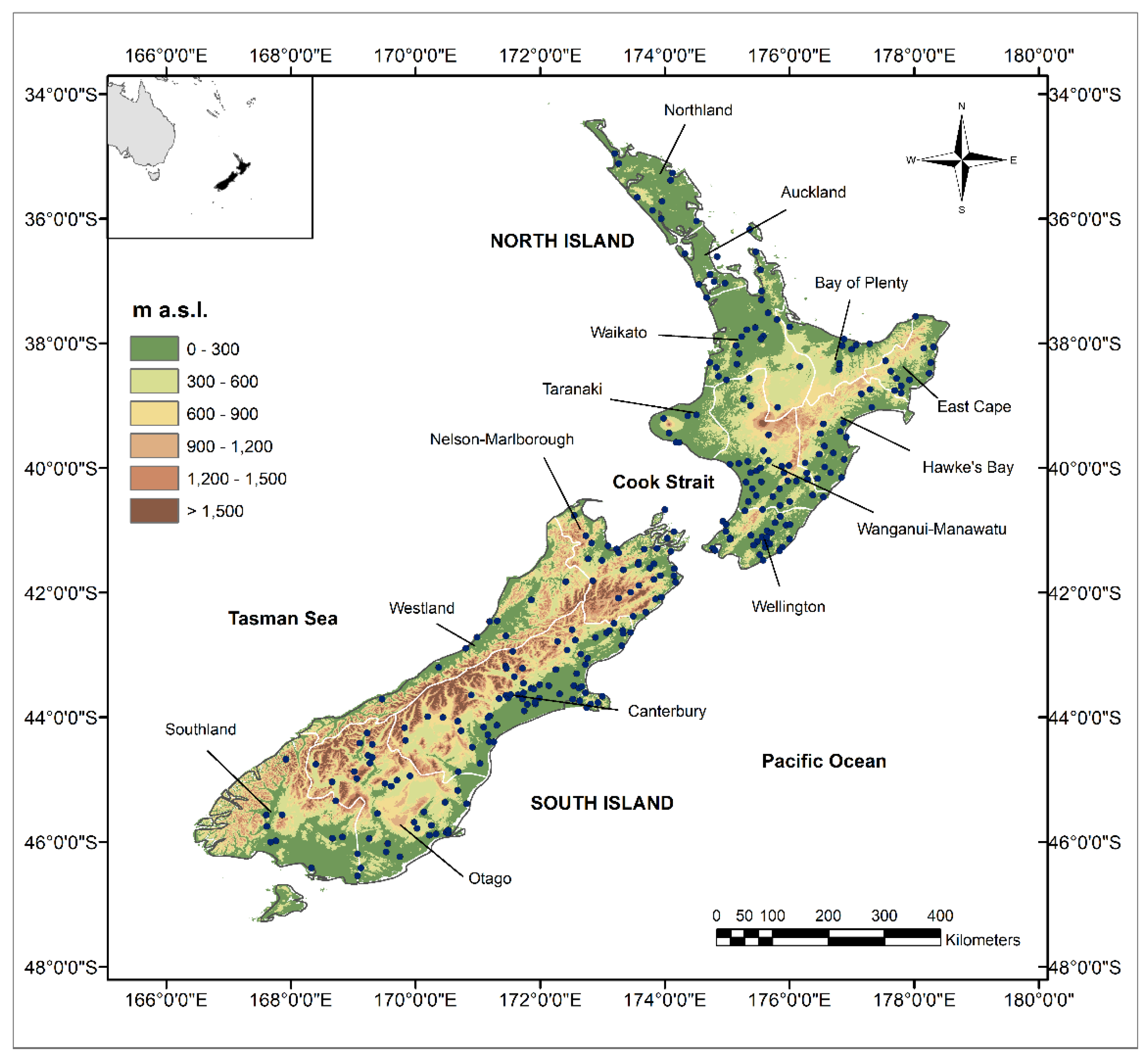
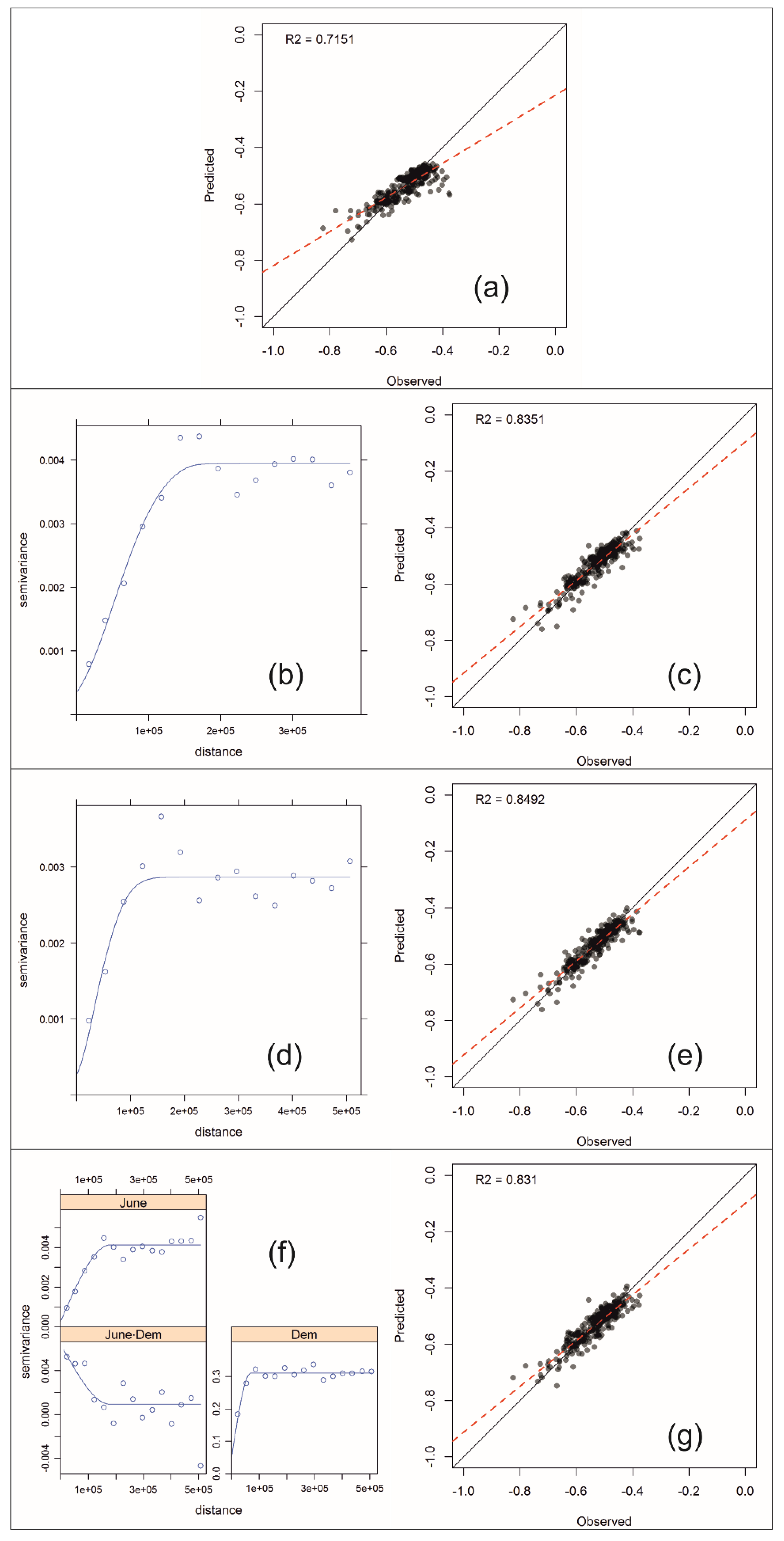
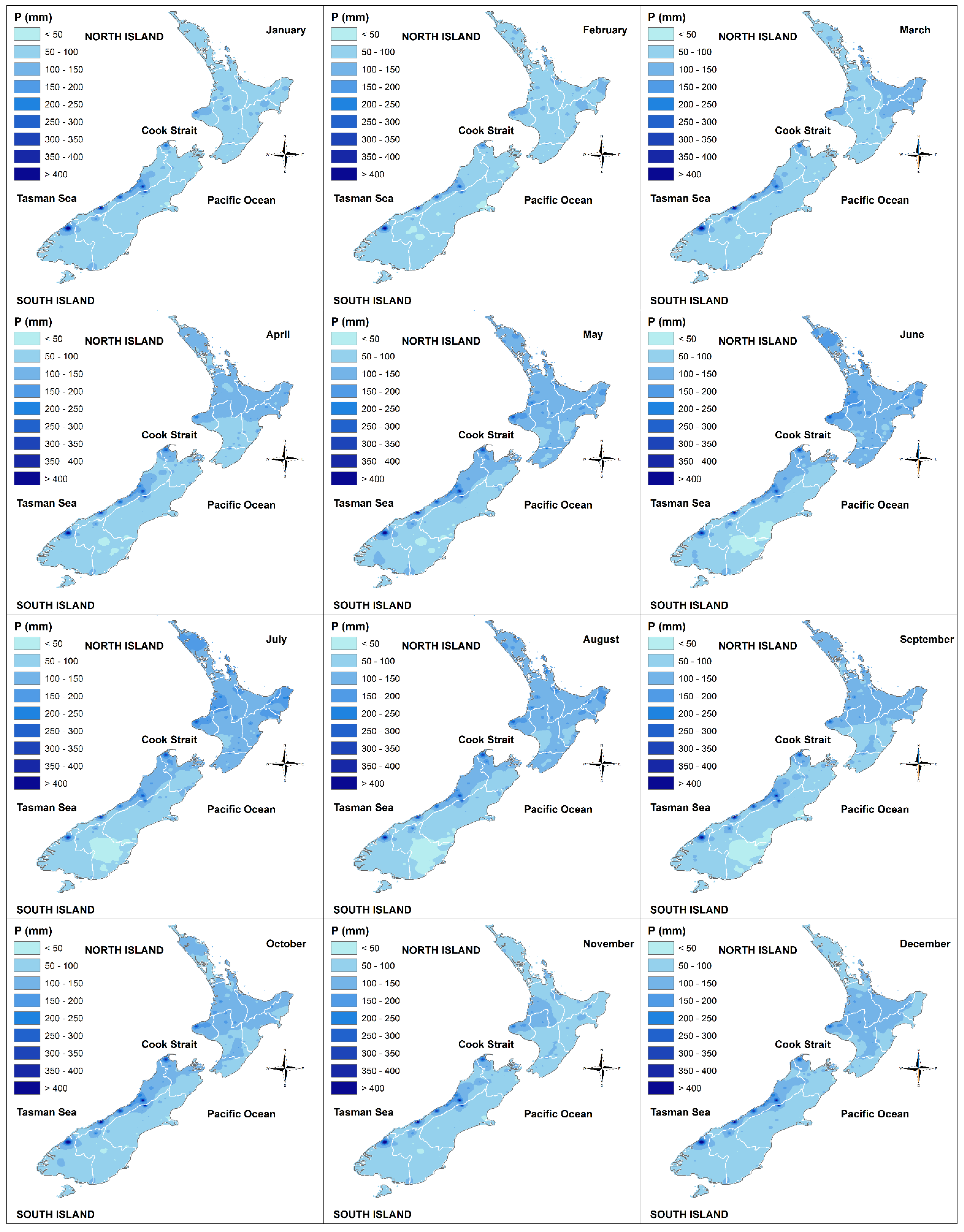

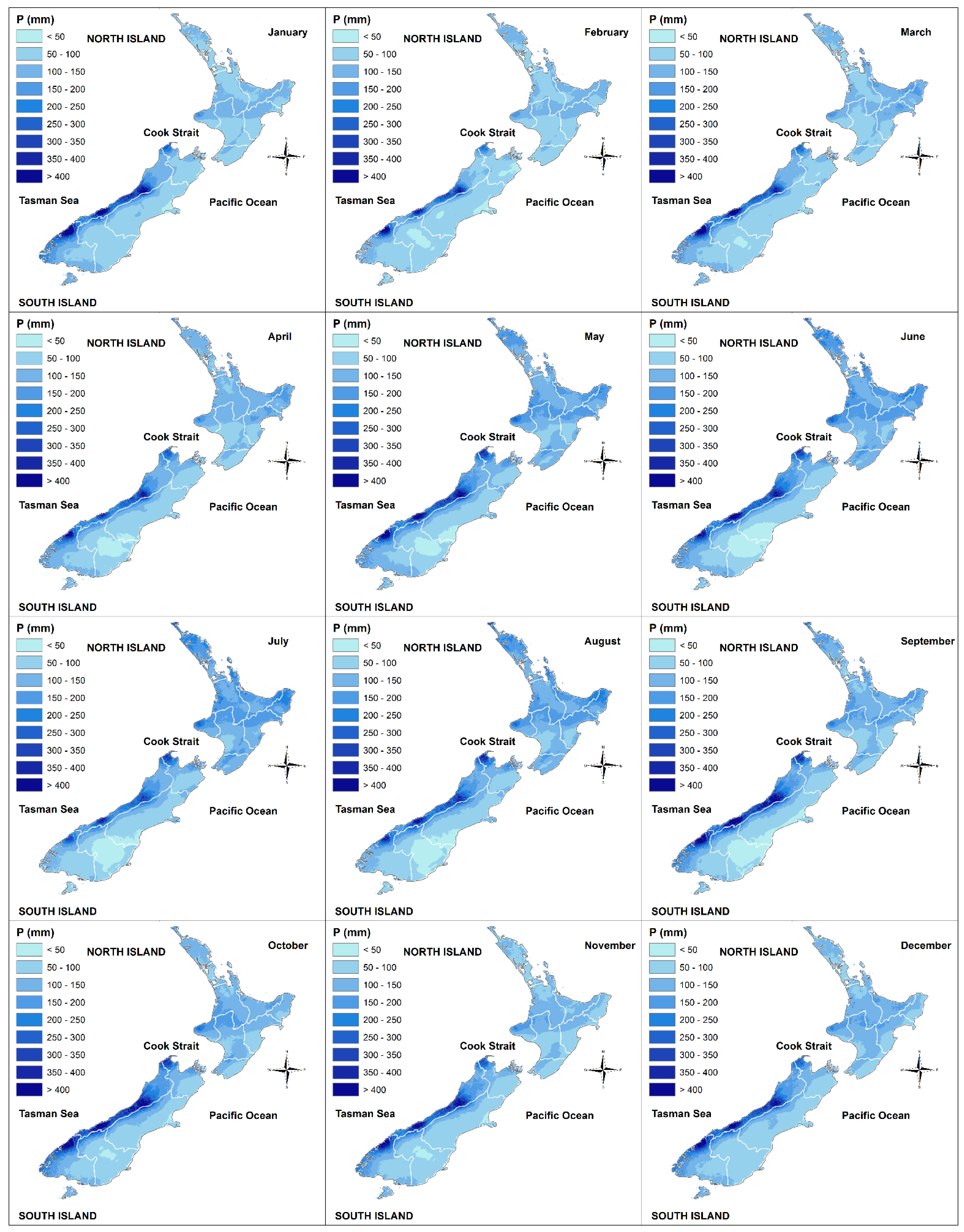
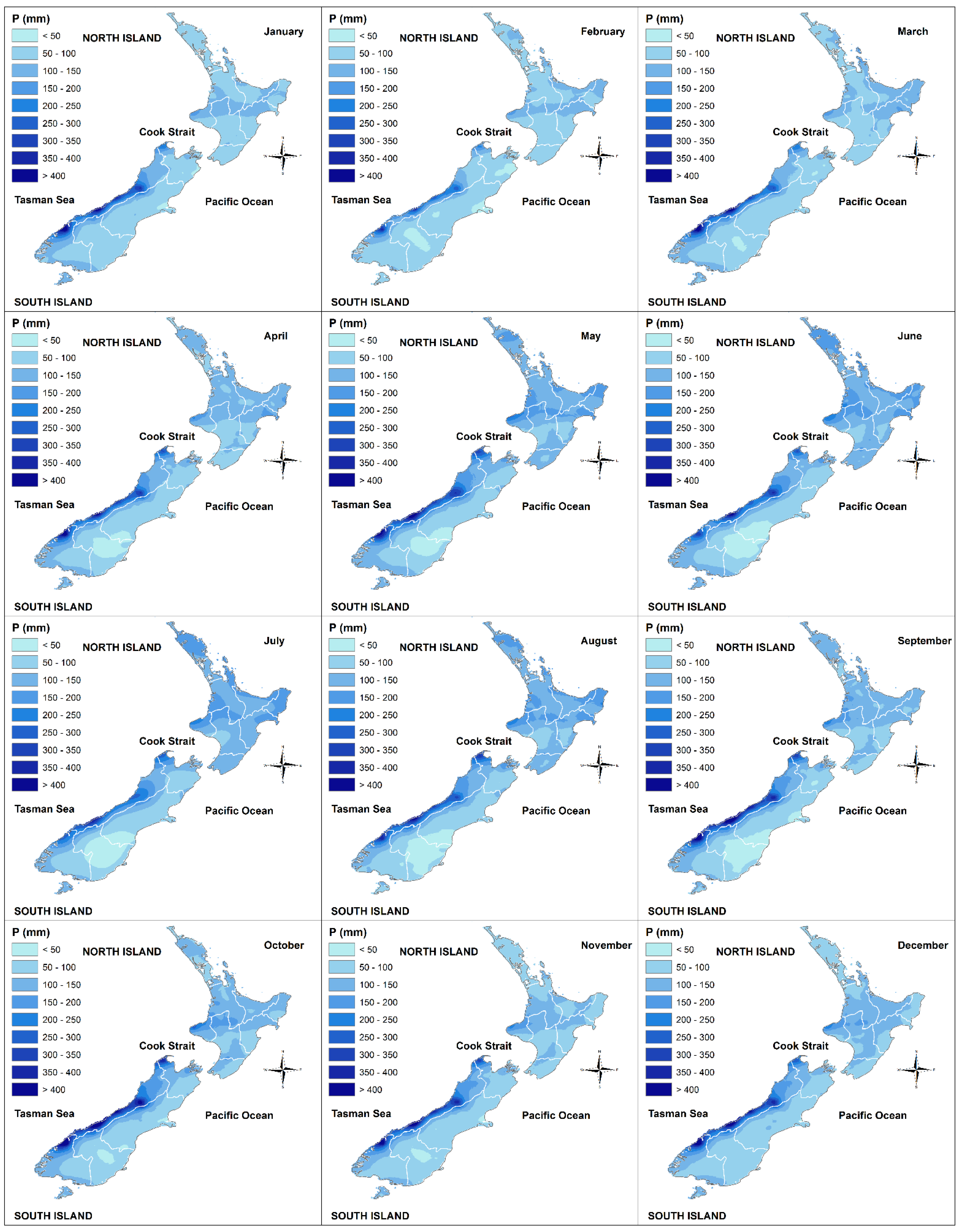
| Month | Mean | Median | Max | Min | CV | SK | KU |
|---|---|---|---|---|---|---|---|
| January | 90.0 | 77.3 | 632.6 | 36.9 | 0.66 | 5.21 | 35.06 |
| February | 83.2 | 73.9 | 512.0 | 27.9 | 0.58 | 4.52 | 29.42 |
| March | 94.4 | 80.9 | 609.7 | 40.8 | 0.60 | 4.81 | 33.29 |
| April | 98.2 | 88.4 | 547.5 | 35.9 | 0.57 | 3.74 | 20.67 |
| May | 113.0 | 102.9 | 553.5 | 31.8 | 0.54 | 3.09 | 14.98 |
| June | 113.8 | 106.0 | 439.5 | 25.8 | 0.53 | 1.90 | 6.31 |
| July | 117.4 | 111.8 | 380.0 | 20.4 | 0.49 | 1.41 | 3.42 |
| August | 110.9 | 101.7 | 433.5 | 21.4 | 0.52 | 1.92 | 6.03 |
| September | 98.9 | 85.6 | 542.3 | 26.5 | 0.64 | 3.42 | 16.52 |
| October | 106.2 | 91.3 | 612.0 | 37.4 | 0.66 | 3.96 | 20.34 |
| November | 94.5 | 79.7 | 573.3 | 34.5 | 0.66 | 4.27 | 23.48 |
| December | 101.8 | 88.7 | 595.5 | 37.2 | 0.61 | 4.26 | 23.93 |
| Month | IDW | OK | KED | COK |
|---|---|---|---|---|
| January | 0.5393 | 0.6375 | 0.7021 | 0.7089 |
| February | 0.5329 | 0.6406 | 0.6711 | 0.6816 |
| March | 0.5318 | 0.6551 | 0.6901 | 0.7098 |
| April | 0.6178 | 0.7449 | 0.7748 | 0.7921 |
| May | 0.6266 | 0.7515 | 0.7748 | 0.7766 |
| June | 0.7151 | 0.8236 | 0.8492 | 0.8486 |
| July | 0.7324 | 0.8277 | 0.8320 | 0.8332 |
| August | 0.7043 | 0.8074 | 0.8194 | 0.8408 |
| September | 0.6569 | 0.7825 | 0.7956 | 0.8055 |
| October | 0.6097 | 0.7459 | 0.7723 | 0.7900 |
| November | 0.5712 | 0.6963 | 0.7168 | 0.7422 |
| December | 0.5562 | 0.6811 | 0.7064 | 0.7319 |
| Month | MAE | RMSE |
|---|---|---|
| January | COK | COK |
| February | COK | COK |
| March | COK | COK |
| April | KED | KED |
| May | KED | COK |
| June | KED | COK |
| July | KED | COK |
| August | COK | COK |
| September | COK | COK |
| October | COK | COK |
| November | COK | COK |
| December | COK | COK |
Publisher’s Note: MDPI stays neutral with regard to jurisdictional claims in published maps and institutional affiliations. |
© 2021 by the authors. Licensee MDPI, Basel, Switzerland. This article is an open access article distributed under the terms and conditions of the Creative Commons Attribution (CC BY) license (https://creativecommons.org/licenses/by/4.0/).
Share and Cite
Caloiero, T.; Pellicone, G.; Modica, G.; Guagliardi, I. Comparative Analysis of Different Spatial Interpolation Methods Applied to Monthly Rainfall as Support for Landscape Management. Appl. Sci. 2021, 11, 9566. https://doi.org/10.3390/app11209566
Caloiero T, Pellicone G, Modica G, Guagliardi I. Comparative Analysis of Different Spatial Interpolation Methods Applied to Monthly Rainfall as Support for Landscape Management. Applied Sciences. 2021; 11(20):9566. https://doi.org/10.3390/app11209566
Chicago/Turabian StyleCaloiero, Tommaso, Gaetano Pellicone, Giuseppe Modica, and Ilaria Guagliardi. 2021. "Comparative Analysis of Different Spatial Interpolation Methods Applied to Monthly Rainfall as Support for Landscape Management" Applied Sciences 11, no. 20: 9566. https://doi.org/10.3390/app11209566
APA StyleCaloiero, T., Pellicone, G., Modica, G., & Guagliardi, I. (2021). Comparative Analysis of Different Spatial Interpolation Methods Applied to Monthly Rainfall as Support for Landscape Management. Applied Sciences, 11(20), 9566. https://doi.org/10.3390/app11209566







